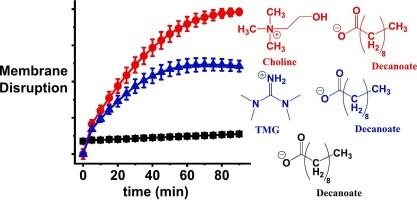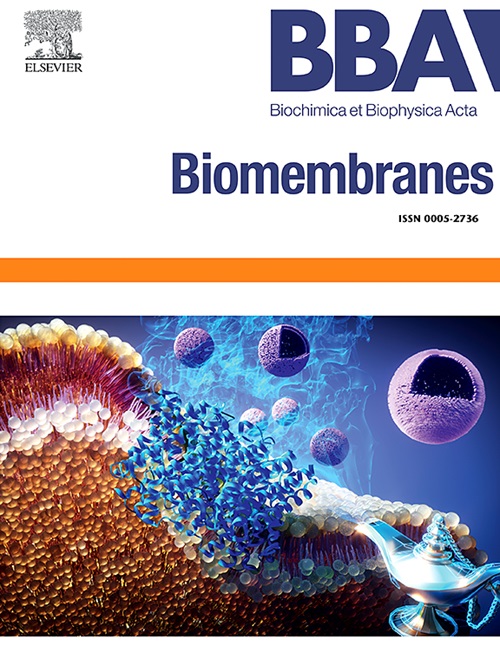四甲基胍和胆碱脂肪酸离子液体的脂质双分子层渗透性和抗生素效应。
IF 2.5
3区 生物学
Q3 BIOCHEMISTRY & MOLECULAR BIOLOGY
引用次数: 0
摘要
离子液体(ILs)具有渗透和穿透脂质双分子层的能力,与抗菌效果相关,因此被研究用作抗生素制剂的潜在成分。脂肪酸基 IL(FAILs)中的阴离子是长链脂肪酸,可以渗透脂膜,由于对人体细胞的细胞毒性较低,因此已被用于生物医学领域。在这项工作中,我们研究了几种不同的 FAILs 对脂质双分子层的渗透能力,以及这种渗透能力与抗菌活性、细胞膜渗透性和细胞毒性之间的关系。FAIL 由阳离子四甲基胍(TMG)或胆碱与辛酸酯或癸酸酯组合而成。在具有三种不同脂质成分的模型双层囊泡上对这些 FAIL 进行了测试,使用渗漏测定法检测其膜渗透性。然后在细菌和哺乳动物细胞上进行了抗生素和膜渗透测试。结果表明,辛酸酯类 FAIL 不能形成胶束,对囊泡和生物细胞的活性较低,而癸酸酯类 FAIL 则能渗透双层膜,并具有与模型囊泡结果相关的生物活性。同时具有阳离子和脂肪酸阴离子的IL具有很强的活性,而单独的癸酸酯只有极低的渗透性和抗生素活性。当 FAIL 的浓度低于其 CMC 值时就会发生膜渗透,这表明它们的作用机制可能不涉及胶束的形成。本文章由计算机程序翻译,如有差异,请以英文原文为准。

Lipid bilayer permeabilities and antibiotic effects of tetramethylguanidinium and choline fatty acid ionic liquids
Ionic liquids (ILs) have been studied as potential components in antibiotic formulations based on their abilities to permeabilize and penetrate lipid bilayer, which correlate with their antibacterial effects. Fatty acid-based ILs (FAILs), in which the anion is a long-chain fatty acid, can permeabilize lipid membranes and have been used in biomedical applications since they have low human cell cytotoxicity. In this work we investigated the abilities of several different FAILs to permeabilize lipid bilayers and how that permeabilization correlates with antibacterial activity, cell membrane permeability, and cytotoxicity. The FAILs consisted of the cations tetramethylguanidinium (TMG) or choline combined with octanoate or decanoate. These FAILs were tested on model bilayer vesicles with three different lipid compositions for membrane permeabilization using a leakage assay. They were then tested for antibiotic and membrane permeabilization on bacterial and mammalian cells. The results show that while the octanoate-based FAILs do not form micelles and have low activities on vesicles and biological cells, the decanoate-based FAILs can permeabilize bilayers and have biological activities that correlate with the model vesicle results. The ILs with both cation and fatty-acid anion have strong activities while the decanoate alone has only minimal permeabilization and antibiotic activity. Membrane permeabilization occurs at FAIL concentrations below their CMC values which suggests that their mechanism of action may not involve micelle formation.
求助全文
通过发布文献求助,成功后即可免费获取论文全文。
去求助
来源期刊

Biochimica et biophysica acta. Biomembranes
生物-生化与分子生物学
CiteScore
8.20
自引率
5.90%
发文量
175
审稿时长
2.3 months
期刊介绍:
BBA Biomembranes has its main focus on membrane structure, function and biomolecular organization, membrane proteins, receptors, channels and anchors, fluidity and composition, model membranes and liposomes, membrane surface studies and ligand interactions, transport studies, and membrane dynamics.
 求助内容:
求助内容: 应助结果提醒方式:
应助结果提醒方式:


